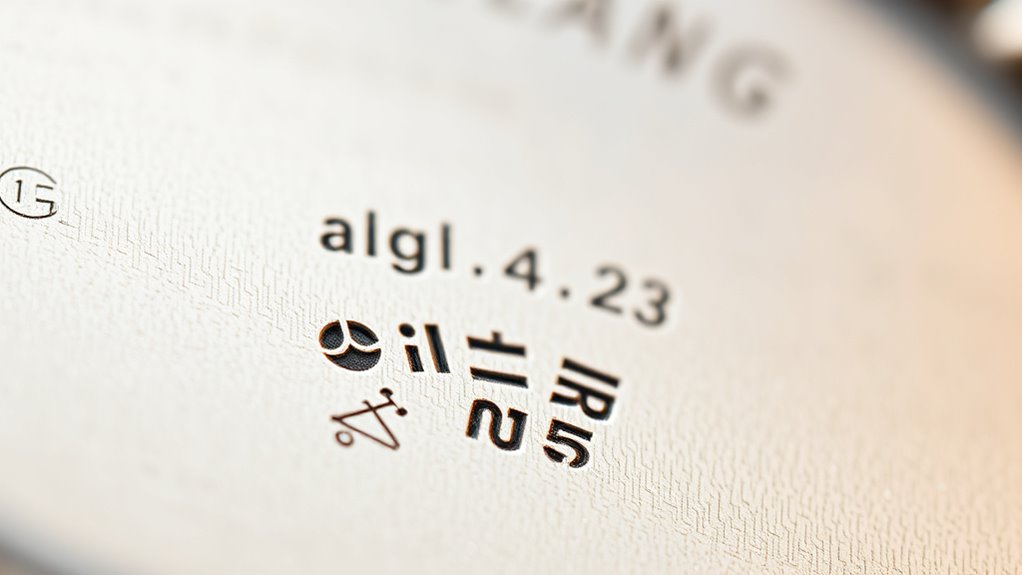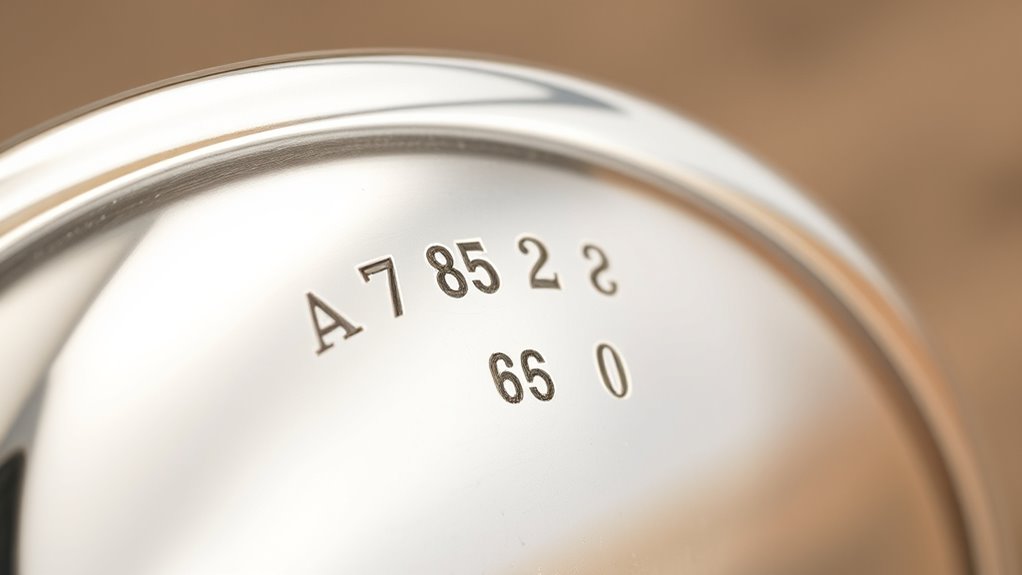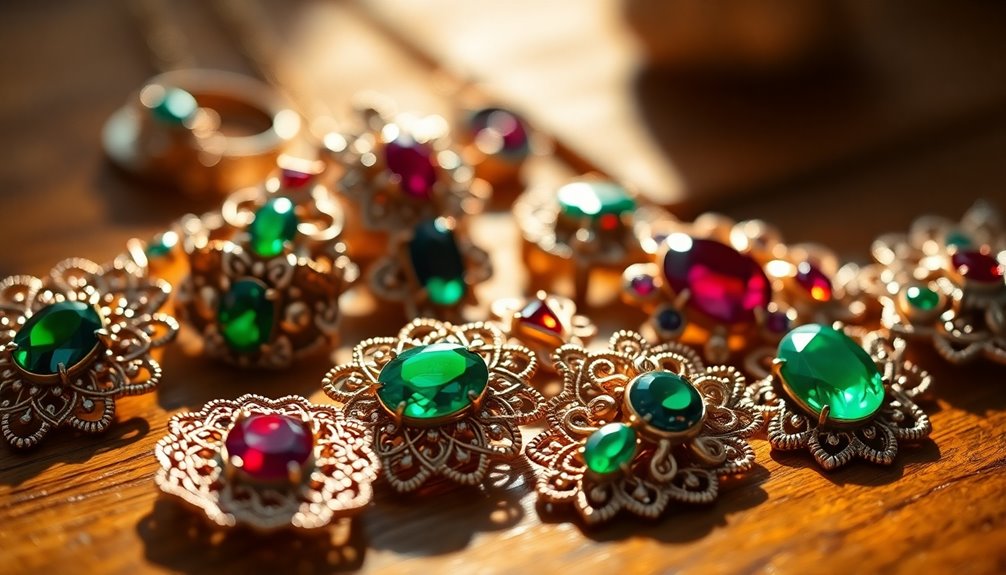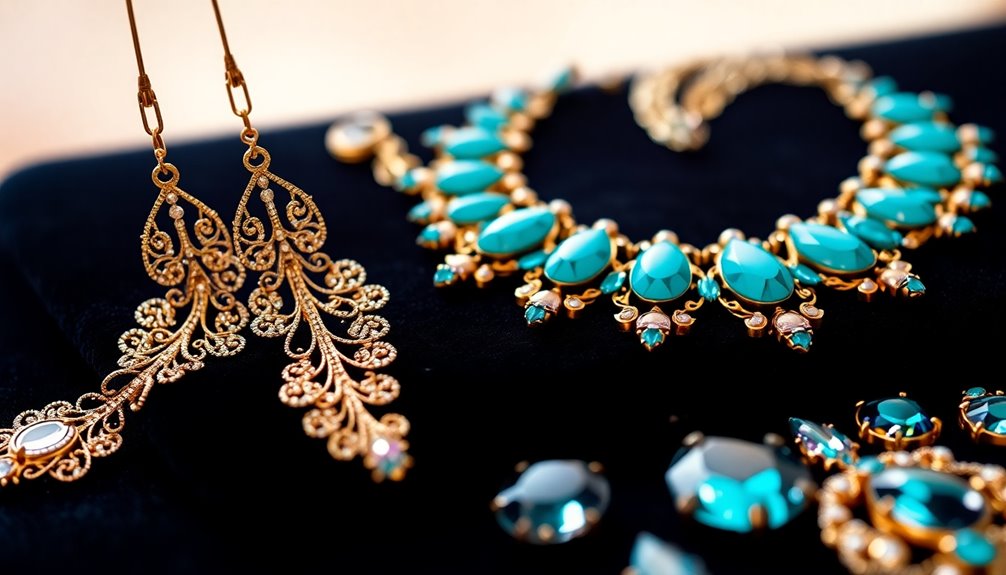Hallmarks and assay marks are symbols and stamps on jewelry that show its purity, origin, and authenticity. They have been used for thousands of years to prove the quality of precious metals like gold, silver, and platinum. These marks usually include purity indicators, geographic details, and assay office symbols. Understanding them helps you confirm a piece’s value and history. Keep exploring to learn more about how these marks protect and certify your jewelry.
Key Takeaways
- Hallmarks and assay marks certify a jewelry piece’s material purity, origin, and compliance with regulatory standards.
- They originate from ancient civilizations and serve as a standardized system for authenticity and provenance.
- Common symbols include purity indicators like 18K, 750, or 925, and may also show assay office and country of origin.
- These marks help verify quality, prevent counterfeits, and enhance the item’s value and trustworthiness.
- They provide consumers with confidence, ensuring jewelry meets recognized standards and reflects craftsmanship and history.

Hallmarks and assay marks serve as essential indicators of a jewelry piece’s purity, origin, and quality. When you see these marks, you’re looking at more than just a symbol; you’re uncovering a story that links centuries of craftsmanship, regulatory standards, and cultural significance. The history significance of hallmarks is profound, stretching back thousands of years when ancient civilizations first began marking their precious metals. These marks were originally used to guarantee material authenticity, ensuring that what you purchased was genuine and of the stated purity. Over time, these symbols evolved into a standardized system that helps you trace a piece’s provenance and confirm its value. They serve as a historical record, connecting modern jewelry to traditions that valued transparency and trust in material quality. Recognizing these marks can also provide insight into the box office success of certain titles, especially when considering their cultural impact and popularity. Understanding the significance of these marks also means recognizing their role in protecting consumers and honest jewelers alike. In an era where counterfeit jewelry can be widespread, assay marks act as a safeguard, verifying the material authenticity of precious metals like gold, silver, and platinum. When you purchase jewelry with these marks, you gain confidence that the piece meets specific purity standards set by regulatory authorities. This transparency helps you make informed decisions, whether you’re buying an investment piece or a sentimental gift. Each mark can tell you about the geographic origin of the metal, the assay office responsible for testing it, and sometimes even the date of manufacture. Material authenticity is central to the value and integrity of your jewelry. Hallmarks and assay marks are the most reliable way to confirm that a piece is made from the genuine material it claims to be. For example, a gold hallmark might include a number indicating its purity, such as 18K or 750, providing instant clarity about its gold content. Silver jewelry often bears a mark like 925, meaning it’s 92.5% pure silver. These marks aren’t just arbitrary symbols; they are the result of rigorous testing and regulation by official assay offices, which verify that the jewelry meets strict standards. By understanding these marks, you ensure that what you’re wearing or gifting is authentic, valuable, and crafted according to recognized quality standards. This confidence, rooted in the history significance and material authenticity conveyed through assay marks, helps you enjoy your jewelry with peace of mind, knowing it’s genuine and backed by centuries of tradition and regulation.
Frequently Asked Questions
How Can I Identify Counterfeit Hallmarks and Assay Marks?
To identify counterfeit hallmarks and assay marks, you should focus on counterfeit detection and mark verification. Check for inconsistencies like misspellings, blurry or uneven marks, or incorrect symbols. Compare the marks with official reference guides or trusted sources. Use a magnifying glass or jeweler’s loupe to examine details closely. Genuine marks are precise and well-defined, while counterfeit ones often show signs of poor craftsmanship or irregularities.
Do Hallmarks Vary Between Different Countries or Regions?
You’ll find that hallmarks do vary markedly between countries, reflecting regional differences in standards and regulations. For example, the UK uses a distinct system, while countries like India or the US have their own marks. Interestingly, international standards aim to harmonize some aspects, but regional differences still influence hallmark designs and what they signify. So, always check local regulations to accurately identify and interpret these marks.
What Should I Do if a Piece Has Missing or Unclear Marks?
If a piece has missing or unclear marks, you should have it professionally tested for metal purity to verify accuracy. Avoid relying solely on the markings, as they can be worn or inaccurate. Check for marking clarity; if the marks are faint or illegible, consult a reputable jeweler or assay office. This way, you’ll confirm the metal’s quality and avoid potential issues with authenticity or value.
Are Assay Marks Always Mandatory on Precious Metal Jewelry?
You might think assay marks are optional, but in reality, jewelry marking regulations often make them mandatory. Assay mark requirements are there to protect you, ensuring the piece’s purity and authenticity. Without these marks, you risk buying or selling jewelry that’s unverified, which can lead to legal troubles or customer distrust. So, yes, assay marks are usually essential, and ignoring jewelry marking regulations can leave you vulnerable.
How Often Are Hallmark Standards Updated or Changed?
Hallmark standards are periodically updated, but not very often. Certification updates depend on regulatory changes or industry needs, so you should stay informed through official assay office announcements. When standards change, jewelry marking regulations are revised to guarantee accuracy and consumer protection. You can check with relevant authorities or industry sources regularly to keep up with the latest hallmark standards and certification updates, ensuring your jewelry remains compliant.
Conclusion
By understanding hallmarks and assay marks, you gain a clearer picture of your jewelry’s story and authenticity. These tiny symbols whisper secrets of craftsmanship and trust, guiding you toward confident choices. When you look closely, you’ll uncover a world of craftsmanship hidden in plain sight. Embrace these marks as your allies, gently reassuring you of quality and origin. After all, a little knowledge makes every sparkle even more special and meaningful.









